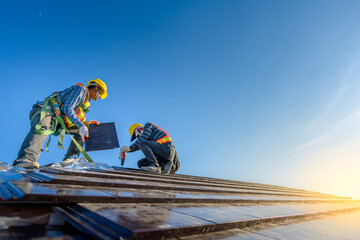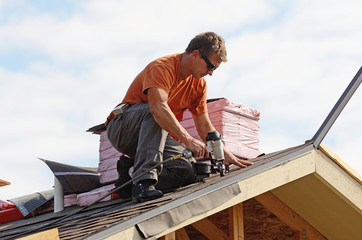Roof Repair Cost – How Much Does Repair a Leaking Roof Cost?
A leaking roof can cause expensive damage quickly, including rotted framing and sheathing and destroyed insulation. So it pays to get repairs done right away when they’re less expensive. The damage type and roof design impact the most on repair cost. But materials, labor, and insurance also factor in.

Materials
The materials needed for roof repair vary by type of roof and extent of damage. The roof repair cost can be reduced if the homeowner uses a product compatible with their specific roof type. These products often include roof sealants and flashings. They are usually available in multiple colors to match the existing roofing material on the house. Homeowners should also ensure they have the proper tools to complete the repair job. This can include a caulk gun, rubber-to-rubber contact cement, acetone, and a utility knife.
Asphalt shingles are the most common roof material and are relatively inexpensive to repair. Metal and wooden shingles are more expensive, but still less than a replacement roof.
Leaks are the most common reason for a roof repair. This can be caused by many things including weather conditions and age of the shingles. Repairing a leaky roof requires finding and repairing the source of the leak. This may require removing the damaged shingles and sealing any open areas.
Ridge caps are the triangular sections of a roof that cover any cracks in the rest of the roof. These can be damaged by water leaking into the house or from fungus buildup on the shingles underneath them. Repairing ridge caps costs about $250 to $750 on average.
A major repair that can be costly is a sagging roof. This can occur when rain or snow accumulates on a roof longer than it should, forcing not only the shingles but the wood structure supporting them to bear excess weight. This can cause severe damage if not addressed.
Another major repair is the need for new gutters. These can be costly depending on the type of gutters chosen and how large they are. The best gutters for a roof are often metal and have a sloped design to help with drainage.
If a homeowner is concerned about the cost of a roof repair, they can apply for a grant to help pay for the work. These are often available from local, state and federal agencies and can be used to address urgent repairs. Some programs have income restrictions to qualify, but they can be a great way for homeowners to get the money they need to keep their homes safe and comfortable.
Labor
The majority of roof repair costs are associated with labor. The price of labor will vary depending on the roofing material used and the extent of damage or repairs needed. Asphalt shingles are on the lower end of the spectrum, while metal and slate tiles are on the higher end. The size of the roof also impacts repair costs, with larger roofs requiring more extensive work and materials than smaller ones. In addition, the season and weather conditions can increase or decrease labor costs. Working on a snowy or icy roof is more dangerous than working on a dry one, so contractors may charge extra for this type of work.
Missing shingles or a hole in the roof require a lot of labor to replace and seal. Depending on the type of roofing, this can cost up to $100 per square foot. Wood shakes and shingle roofs cost more to repair than metal ones, since they are made from more delicate wood that can be damaged by water.
Chimney flashing is a sheet of metal, usually aluminum, that helps prevent water leaks around the chimney. The flashing is exposed to the elements and can corrode over time, leading to a leak in the ceiling or at the corners of the roof. Replacing the flashing can cost $200 to $500.
A sagging roof can develop from many different problems, including a build-up of snow or water that weighs down the shingles and boards. A contractor can inspect the roof and recommend an appropriate repair.
Leaks are a common problem that can cause significant structural damage if left unrepaired. This damage can be caused by a variety of factors, including age, improper installation, and water damage from heavy condensation or AC ductwork.
Skylights and dormers add light and space to a room, but they also increase the risk of leaks since they’re at the highest point on the roof. A licensed roofer can find the source of a leak and install flashing to prevent future leaks.
Ventilation is important for a healthy home, but roof vents can wear out quickly from exposure to the elements. A roofer can install new vents or fix existing ones, which typically costs $75 to $250.
Inspections
Your roof is your home’s first line of defense against extreme weather. It must deal with heavy snow, high winds, rain and sun. Because it is so important, it’s often taken for granted until a leak appears in the ceiling. Taking the time for regular inspections can save you money and headaches later on.
A professional inspector will look at the quality of materials used and how they are installed. He will check the shingles and roof tiles for any chips, cracks or breaks. He will also make sure the shingles are properly fitted and secured to the roof structure. In addition, he will inspect the flashings around chimneys, dormers and vent pipes. These flashings are usually made of metal and redirect water runoff from areas where it isn’t needed. If they are damaged, they can cause rot in the roof structure and walls of your house.
He will examine the gutter system for any rust or leaking spots and make sure that it is properly secured to the roof. He will also check the interior of the roof, including the attic and interior walls, for stains, mold, mildew and water damage. He may also inspect the soffit and fascia for any signs of rotting or insect infestation. He will also examine the ventilation system of the attic to ensure that it is not overly restrictive.
Some roofers offer free inspections. This is a scam. A good roofing contractor will not be able to perform a thorough inspection without going up on the roof. Besides, it’s unsafe and impractical for a homeowner to get up on their own roof.
A good roofer will give you an estimate before starting the job. He will be able to tell you whether your roof needs repair or replacement. He will also recommend any other necessary work. It’s best to get this estimate in writing so that you have it in case you need to file an insurance claim or if the roofer starts performing less-than-thorough work. It’s also important to know the cost of the inspection so that you can compare it with the price of the roof repair.
Insurance
Some homeowners insurance policies have provisions that cover part of the cost of roof repair. Typically, though, your insurer will reimburse you for up to the amount of your policy’s deductible.
If your roof is damaged by a storm, or you discover a leak, it’s important to make an insurance claim as quickly as possible. The longer you wait, the more likely it is that your insurance company will deny your claim. Keeping good records of damage, including photos and dates when you spoke to your insurer and contractors, can help you win the case for your claim.
It’s also smart to work with an insurance-approved contractor to get the most value out of your claim. Many home insurers offer a list of contractors that they work with regularly. They’re often cheaper than regular contractors, and they provide a warranty on their work. Some even pay for an inspection and a quote to their policyholders, which can save you money on your repair bill.
Your homeowners policy may also cover other aspects of a roof’s repair or replacement cost. These include a code upgrade provision, which covers any upgrades needed to bring your home’s roof up to current codes and standards. Some policies also have replacement cost coverage, which means that your insurer will replace your roof at today’s price. This is important, because your roof will depreciate over time.
Homeowners insurance is designed to minimize avoidable risk. If your home is located in a dangerous area, for example, an insurer may raise the rate or exclude the building from certain coverages. It might also impose higher deductibles on certain coverages, especially for storm damage caused by wind or hail.
You should always consider the cost of a roof repair against your insurance deductible before you file a claim. Also, keep in mind that filing too many claims can negatively impact your insurance premiums when you’re ready to renew your policy.



